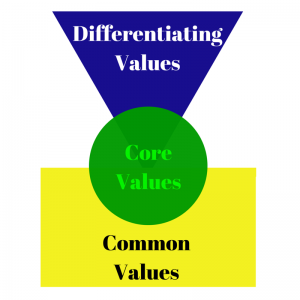Why Employees Shouldn’t Pick Company Values
 I recently read an article suggesting companies should “Crowdsource” their values. On the surface, the concept of engaging employees appears logical.
I recently read an article suggesting companies should “Crowdsource” their values. On the surface, the concept of engaging employees appears logical.
Who better to represent the company culture than existing employees? In addition to obtaining immediate buy-in, it also feels like a great way to involve everyone.
But this is NOT a good way to pick company values.
Here’s why:
In an effort to appease employees, leaders pick too many values. This makes the values useless.
Too Many Values
Here’s a list of major corporations that have way too many values:
- Amazon lists 14 leadership principles
- Honeywell lists 12 behaviors
- O’Reilly Auto Parts lists 12 values that define their business philosophy
- United Airlines (pre-merger) lists 12 Customer Commitments
- World Fuel Services lists 12 core competencies
- Nike lists 11 principles
- Frontier Communications lists 11 values
- Google lists “10 things we know to be true”
- Sprint lists 10 “Imperatives”
- Nationwide lists 10 values (4 core + 6 performance)
It’s doubtful that the leaders – let alone the employees – at these companies can list all (if any) of their company values.
Then there are numerous companies that list fewer values, yet manage to define them in such a way that they try and incorporate everything “including the kitchen sink.” Some even produce booklets that are 20 or more pages describing in great detail what all the values mean.
Values are meaningless unless employees can easily describe the company values to their friends.
Many experts and business consultants, including Ken Blanchard, argue that employees can only remember 3 to 4 values. In other words, 3 is the magic number.
Support from an Expert
Patrick Lencioni, a well-respected business consultant, is the author of numerous business books, including: The Advantage: Why Organizational Health Trumps Everything Else In Business
. In this book, Lencioni states that many business leaders followed the trend to create a set of company values that turned out to be uninspiring and problematic.
Lencioni writes:
“The mistake those leaders made was trying to be all things to all people, which led them to make their value statements as broad and inclusive as possible. In many cases, this comes about because leaders conduct a survey asking employees to vote on which values they want, and then they try to accommodate all of the input they receive. Let me be very clear: this is a terrible process for identifying core values…”
He then adds:
“When an organization announces that it has nine core values…. it makes it impossible to use those values to make decisions, hire employees, or enact policies. After all, no action, person, or policy can meet all of those criteria.”
To drive the point home, Lencioni then states:
“When leaders who adopt too many values finally realize what they’ve done and that there is no hope for actually putting their many values to practical use, they often end up ignoring them altogether.”
The reason business leaders violate stated values is because there’s too many.
So if you don’t want to set yourself up for failure (or the company), don’t ask your employees to pick your company values. Instead, choose a proven process to select 3 (maximum 4) values that are unique (to the company), relevant (to customers), and sustainable (by all employees).
Where do you think employees should be involved in the selection of company values?









